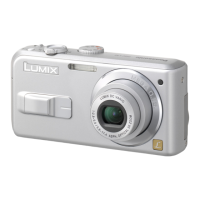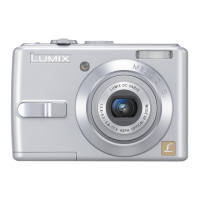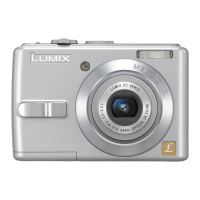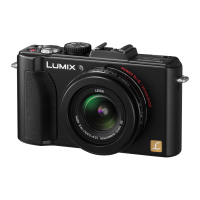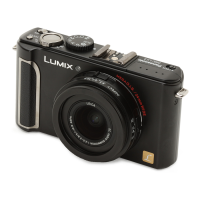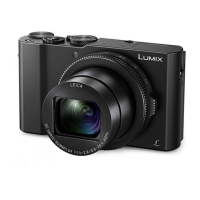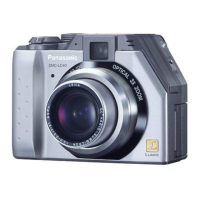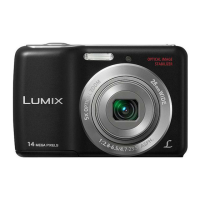
Do you have a question about the Panasonic Lumix DMC-LS5 and is the answer not in the manual?
| Brand | Panasonic |
|---|---|
| Model | Lumix DMC-LS5 |
| Category | Digital Camera |
| Language | English |
Keep the camera away from excessive vibration, force, or pressure.
Condensation may occur when the camera is exposed to sudden changes of temperature or humidity.
Before important events, always take a test shot to make sure pictures and sound record correctly.
We cannot compensate for missed shots if technical problems prevent recording.
Unauthorized use of copyrighted material for purposes other than personal use is prohibited.
Memory cards are optional. You can record or play back pictures on the built-in memory when you are not using a card.
Identifies key buttons and features on the camera's exterior.
Explains the operation of the cursor button for navigation and selection.
Lists compatible battery types (alkaline, Ni-MH) and incompatible types.
Provides estimated numbers of pictures and operating times with different battery types.
Explains how low temperatures affect battery performance, especially for alkaline batteries.
Instructions for sliding the card/battery door open.
Instructions for inserting batteries and cards, emphasizing correct orientation.
Instructions for closing the card/battery door securely.
Step-by-step guide on how to safely remove batteries from the camera.
Step-by-step guide on how to safely remove the memory card from the camera.
Explains where pictures are saved (card vs. built-in memory).
Lists compatible SD memory card types and capacities.
Table showing the number of still pictures that can be recorded based on card capacity and picture size.
Table showing recording time for motion pictures based on card capacity and quality.
Detailed instructions for setting the camera's date, time, and format.
Select [Clock Set] from [Setup] or [Rec] menu to change time settings.
Guide to selecting mode and taking pictures with automatic settings.
Tips for holding the camera steady to avoid shake.
Options for setting the flash mode, including Auto and Red-Eye Reduction.
Camera identifies scenes automatically (people, scenery, close-up, night).
Lists menu items that can be set in [Intelligent Auto] Mode and fixed settings.
Instructions on how to use the zoom buttons (W/T) to zoom in and out.
Explanation of Optical Zoom and Extra Optical Zoom features for magnification.
Guide to selecting mode, starting, and ending video recording.
Guide to entering playback mode and scrolling through images.
Press the 'T' side of the zoom button to magnify pictures.
Instructions for playing back recorded motion pictures.
Controls for pausing, rewinding, and fast-forwarding motion pictures.
Guide to entering playback mode and switching to multiple image display.
Press the delete button to initiate deletion of the current picture.
Steps to select multiple pictures or all pictures for deletion.
Overview of the menu screen layout and components.
Steps for navigating and changing settings within the camera menus.
Explanation of different menu types and their purposes.
Step-by-step guide on changing the [AF Mode] setting in the [Rec] menu.
Set the camera's time, date, and display format.
Adjust the volume of beep sounds and speaker output.
Configure the camera to turn off automatically after a period of inactivity.
Correct LCD monitor flickering caused by indoor lighting.
Automatically display still pictures immediately after taking them.
Reset camera settings to their default values.
Check the version of the camera's firmware.
Format built-in memory or memory card, deleting all data.
Change the language displayed on the camera's screen.
Guide to selecting mode and taking pictures with manual control.
Overview of available recording modes: Intelligent Auto, Normal Picture, Scene Mode, Motion Picture.
Align the AF area with the subject and hold the shutter halfway.
Information on the camera's focus range and potential difficulties.
Press the DISP. button to cycle through display options.
Guide to accessing and choosing desired flash modes.
Details on each flash mode, its operations, and typical uses.
Table showing flash availability across different recording modes and scene modes.
Details the effective flash range for wide and telephoto zoom.
Guide to selecting timer duration and taking pictures with self-timer.
Guide to accessing and adjusting exposure levels for better brightness.
Guide to selecting the appropriate scene mode for optimal results.
Improves skin tone for healthier appearance in bright daylight.
Optimized for taking pictures of yourself.
Takes clear pictures of wide, distant subjects.
Guides taking multiple pictures for creating a panorama with software.
Captures fast-moving subjects like sports.
Takes pictures of people and nightscapes with close to actual brightness.
Takes clear pictures of night scenes.
Takes natural-looking pictures of food.
Brightens indoor events like weddings.
Uses weak flash to bring out skin colours and record age.
Takes clear pictures of scenes such as sunsets.
Prevents blurring of subject in dark, indoor conditions.
Takes clear pictures of fireworks in the night sky.
Brings out clear blues of the sky and sea.
Brings out the natural colour of snow.
Set the size (number of pixels) of still pictures, affecting recording capacity.
Set the picture size and aspect ratio for motion pictures.
Set ISO Sensitivity manually for different lighting conditions.
Adjust coloring to suit light source for natural color reproduction.
Change focus method based on subject position and number.
Magnifies images up to 4 times, potentially reducing picture quality.
Take rapid succession of still pictures while the shutter button is held down.
Automatically detects and corrects red-eye when recording with flash.
Automatically detects and prevents camera jitter.
Set the clock, same function as in [Setup] menu.
View pictures one by one in sequential order.
Automatically plays back still pictures in order.
Narrow down pictures displayed to view only a selected category.
Automatically plays back still pictures in order.
Adjust settings like duration and repeat for the slide show.
Select a category to view specific pictures, such as those taken in Scene Modes.
Reduce picture size for email or web use.
Resize multiple pictures at once (up to 50).
Set protection to disable picture deletion, preventing accidental removal.
Copy pictures between built-in memory and memory card.
Connect the camera to your computer using the supplied USB cable.
Select the PC connection mode on the camera.
Use your computer to import pictures and manage files.
Explains the standard folder and file naming conventions used by the camera.
Manage recorded pictures using the PHOTOfunSTUDIO software.
Connect the camera to a PictBridge-compatible printer.
Select the PictBridge mode on the camera.
Choose the picture(s) you want to print.
Initiate the printing process with selected settings.
Select multiple pictures for printing or print all pictures.
Options for printing the recording date on pictures.
Adjust print settings like number of prints, paper size, and layout.
Details of various icons and information displayed on the LCD screen during recording.
Details of icons and information displayed on the LCD screen during playback.
Explanation for non-DCF pictures that cannot be deleted.
Troubleshooting for lens malfunction or system errors.
Indicates insufficient space on built-in memory or memory card.
Error message when the memory card format is not supported.
Error when card is not SD standard or capacity is not supported.
Cancellation due to writing speed limitation of the memory card.
Error when folder numbers reach the limit (999).
Troubleshooting for power-related problems like camera turning off unexpectedly.
Solutions for problems like cannot record pictures, pictures too bright/dark, or blurred.
Troubleshooting for coarse pictures, interference, or color differences.
Reasons why motion picture recording might stop unexpectedly.
Troubleshooting for LCD monitor shutting off, unstable brightness, or flickering.
Reasons why flash might not emit and troubleshooting for playback problems.
Low playback or beep volume, or issues with motion picture sound.
Troubleshooting for white spots, blackened red areas, or poor picture quality.
Troubleshooting for issues sending pictures to computer or printing.
Troubleshooting for menu display, camera heat, clicking noise, and clock incorrectness.
Precautions for using the camera, avoiding electromagnetic interference.
Instructions for cleaning the camera body and lens.
Recommendations for storing the camera and accessories when not in use.
Cautions for handling memory cards to prevent damage to data.
Guidelines for handling the LCD monitor to prevent damage or display issues.
Precautions for battery removal, storage, and handling.
Detailed advice on handling batteries, including low temperature performance and rechargeable Ni-MH batteries.
Considerations regarding personal information stored on the camera or memory card.
Details about power source, consumption, and image sensor.
Optical specifications of the camera's lens, including zoom and aperture.
Key camera settings and their ranges.
Specifications of the LCD monitor and flash.
Supported types of recording media and resolutions.
File formats for pictures/videos and digital interface details.
Physical specifications and operating conditions.
